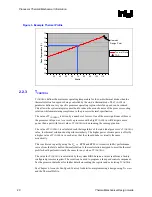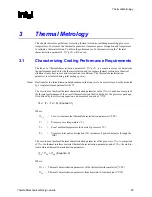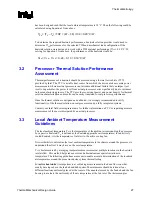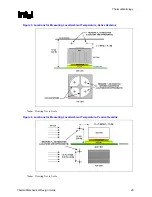
Processor Thermal/Mechanical Information
R
16
Thermal/Mechanical Design Guide
The primary function of the IHS is to transfer the non-uniform heat distribution from the die to
the top of the IHS, out of which the heat flux is more uniform and spread over a larger surface
area (not the entire IHS area). This allows more efficient heat transfer out of the package to an
attached cooling device. The top surface of the IHS is designed to be the interface to the heatsink.
The IHS also features a step that interfaces with the LGA775 socket load plate, as described in
LGA775 Socket Mechanical Design Guide
. The load from the load plate is distributed across two
sides of the package onto a step on each side of the IHS. It is then distributed by the package
across all of the contacts. When correctly actuated, the top surface of the IHS is above the load
plate allowing proper installation of a heatsink on the top surface of the IHS. After actuation of
the socket load plate, the seating plane of the package is flush with the seating plane of the socket.
Package movement during socket actuation is along the Z direction (perpendicular to substrate)
only. Refer to the
LGA775 Socket Mechanical Design Guide
for further information about the
LGA775 socket.
The
datasheet gives details on the IHS geometry and tolerances, and material.
The processor package has mechanical load limits that are specified in the processor datasheet.
The specified maximum static and dynamic load limits should not be exceeded during their
respective stress conditions. These include heatsink installation, removal, mechanical stress
testing, and standard shipping conditions.
•
When a compressive static load is necessary to ensure thermal performance of the thermal
interface material between the heatsink base and the IHS, it should not exceed the
corresponding specification given in the processor datasheet.
•
When a compressive static load is necessary to ensure mechanical performance, it should
remain in the minimum/maximum range specified in the processor datasheet
•
The heatsink mass can also generate additional dynamic compressive load to the package
during a mechanical shock event. Amplification factors due to the impact force during shock
must be taken into account in dynamic load calculations. The total combination of dynamic
and static compressive load should not exceed the processor datasheet compressive dynamic
load specification during a vertical shock. For example, with a 0.454 kg [1 lb] heatsink, an
acceleration of 50G during an 11 ms trapezoidal shock with an amplification factor of
2 results in approximately a 445 N [100 lbf] dynamic load on the processor package. If a
178 N [40 lbf] static load is also applied on the heatsink for thermal performance of the
thermal interface material the processor package could see up to a 623 N [140 lbf]. The
calculation for the thermal solution of interest should be compared to the processor datasheet
specification.
No portion of the substrate should be used as a load-bearing surface.
Finally, the
datasheet
provides package handling guidelines in terms of maximum recommended
shear, tensile and torque loads for the processor IHS relative to a fixed substrate. These
recommendations should be followed in particular for heatsink removal operations.
Содержание 640 - Pentium 4 640 3.2GHz 800MHz 2MB Socket 775 CPU
Страница 14: ...Introduction R 14 Thermal Mechanical Design Guide ...
Страница 38: ...Thermal Management Logic and Thermal Monitor Feature R 38 Thermal Mechanical Design Guide ...
Страница 52: ...Intel Thermal Mechanical Reference Design Information R 52 Thermal Mechanical Design Guide ...
Страница 60: ...Acoustic Fan Speed Control R 60 Thermal Mechanical Design Guide ...
Страница 72: ...Heatsink Clip Load Metrology R 72 Thermal Mechanical Design Guide ...
Страница 97: ...Mechanical Drawings R Thermal Mechanical Design Guide 97 Figure 48 Reference Clip Drawings Sheet 1 ...
Страница 98: ...Mechanical Drawings R 98 Thermal Mechanical Design Guide Figure 49 Reference Clip Drawings Sheet 2 ...
Страница 99: ...Mechanical Drawings R Thermal Mechanical Design Guide 99 Figure 50 Reference Fastener Sheet 1 ...
Страница 100: ...Mechanical Drawings R 100 Thermal Mechanical Design Guide Figure 51 Reference Fastener Sheet 2 ...
Страница 101: ...Mechanical Drawings R Thermal Mechanical Design Guide 101 Figure 52 Reference Fastener Sheet 3 ...
Страница 102: ...Mechanical Drawings R 102 Thermal Mechanical Design Guide Figure 53 Reference Fastener Sheet 4 ...
Страница 103: ...Mechanical Drawings R Thermal Mechanical Design Guide 103 Figure 54 Clip Heatsink Assembly ...
Страница 104: ...Mechanical Drawings R 104 Thermal Mechanical Design Guide Figure 55 Intel R RCBFH 3 Reference Solution Assembly ...
















































